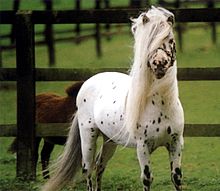Falabella
 A Falabella stallion | |
| Country of origin | Argentina |
|---|---|
| Breed standards | |
The Falabella miniature horse is one of the smallest breeds of horse in the world, seldom taller than 8 hands (32 inches, 81 cm) in height at the withers.[1] The Falabella, despite its size, is not considered a pony, but rather is a miniature horse.
History of the Falabella
The ancestral stock of the horse of South America descended from horses brought to the western hemisphere by the Spanish of Andalusian and other Iberian bloodlines. In the southern part of the continent, significant numbers of these horses developed within geographically isolated conditions and by the mid-19th century, there were any number of smaller, inbred animals in the herds of Mapuche Indians of southern Buenos Aires province in Argentina.[2] The Falabella horse was originally developed in Argentina from local horses of Criollo stock, beginning in 1868 with the breeding program of Patrick Newtall. When Newtall died, the herd and breeding methods were passed to Newtall's son-in-law, Juan Falabella. Juan added additional bloodlines, including the Welsh Pony, Shetland pony, and small Thoroughbreds. With considerable inbreeding, he was able to gain consistently small size within the herd.
Beginning in the 1940s, a descendant, Julio C. Falabella, created a formal breed registry, the Establecimientos Falabella, now the Asociación de Criadores de Caballos Falabella (Falabella Horse Breeders Association), and worked to standardize the breed to reach a consistent height, first achieving an average size of under 100 cm (40 in) Later breeders developed the modern standard, a horse breed that averaged approximately 76 cm (30 in) in height.[2]
The first Falabella horses were imported to the United States In 1962, when John Aleno of Argentina sold 12 Falabella stallions to the Regina Winery in Etiwanda, California. Aleno had purchased the stallions from Julio Falabella. The winery used them to drive a small stagecoach in parades to promote their wine. Most of the Falabella miniature horses in the United States today descend from these 12 stallions.[3]
Characteristics
Average breed heights for a fully-grown Falabella today are between 71 and 86 cm (28 and 34 in).[4] The breed is proportioned similarly to horses, other than in size. They are similar to Thoroughbreds or Arabs in their conformation, with a sleek coat and a slim frame. The Falabella’s body is small and compact. The breed also inherited some cob-like features from pony bloodlines, including sturdy bone, and a thicker hair coat, particularly the mane, tail and around the fetlocks. The head may be slightly larger and the neck is often stouter by comparison with a normal-sized horse, but overall, the animal is not unusually or abnormally proportioned.
Bay (or a variant of bay, called "brown") and black are the most common colors, but there are also pintos, palominos and other spotting patterns found. Black or red leopard-spotted Falabellas (resembling, but not the same as the Appaloosa horse breed) also exist, but are not common.[2]
Falabella foals are very small, standing around 30 to 56 cm (12 to 22 in) tall at birth, and maturing to their adult height by the age of three. They generally stand between 76 and 86 cm (30 and 34 in) tall when fully mature.[5] They are considered very hardy and consistently pass on size, conformation and temperament.[2]
Uses
Most Falabellas are considered intelligent and easily trainable. Due to their size, Falabella horses can only be ridden by very small children, and thus are generally shown in-hand at horse shows. They can be taught to drive, and cart driving is a common use for Falabellas. They also jump obstacles up to 90 cm (3 ft), though in-hand, without a rider.[6]
As they are a show and companion breed, their "useful" lifespan is not limited. While young horses may fetch steep prices and are even sold as a long-term investment, old horses are more readily available.
Falabellas can also be used as guide animals due to their small size and easy trainability.
References
- ^ Horse Trivia
- ^ a b c d "Falabella miniature horse." from International Museum of the horse
- ^ http://cruzminihorses.com/
- ^ Falabella Miniature Horse Association
- ^ Lynghaug, Fran. The Official Horse Breeds Standards Guide. p. 481.
- ^ Robinson, Richard I. "Falabella Miniature Horses." Western Horseman, July, 1965. Accessed online November 23, 2007
